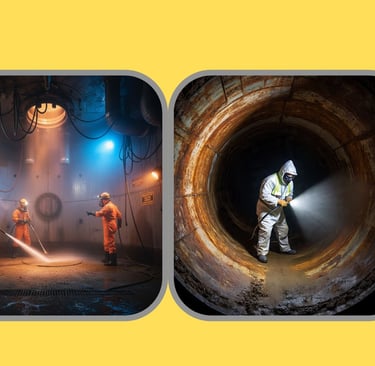Method Statement for Confined Space Tank Cleaning
Even though tank cleaning activity is easy job, but when confined space tank is involved, then task becomes critical. By taking all the necessary safety precautions as mentioned in blog, we can complete the task safely.
Ganpat Shinde
11/1/20253 min read


Tank cleaning is a critical maintenance task, but when it involves a confined space, the risks is at high level. A poorly executed job can lead to serious injury or even death. That's why a robust and detailed Method Statement is mandatory. It is your blueprint for safety, ensuring every hazard is identified and controlled before a worker enters the tank.
What Makes Tank Cleaning a High-Risk Confined Space Activity?
A tank is typically classified as a "Permit-Required Confined Space" because it meets three criteria:
Large enough and configured for a person to enter and perform work.
Limited or restricted means for entry or exit (e.g., small manhole).
Not designed for continuous human occupancy.
The potential hazards within tanks often include:
Atmospheric Hazards: Oxygen deficiency/enrichment, flammable or toxic gases (e.g., Hydrogen Sulfide, Carbon Monoxide or residual fuel vapors).
Physical Hazards: Engulfment by liquids or solids, falling objects, slip/trip hazards, chemical exposure or heat stress.
Key Elements of a Safe Tank Cleaning Method Statement
Your Method Statement (often coupled with a Risk Assessment - MS/RA) must systematically address all phases of the work. Here are the crucial components:
1. Pre-Entry Planning & Authorization
This is where the work is made safe on paper first.
Risk Assessment: A thorough review to identify all potential hazards based on the tank's previous contents, size and layout.
Permit-to-Work (PTW) System: Mandatory for confined space entry. This permit outlines the scope of work, hazards, control measures, necessary equipment and authorized personnel.
Isolation and Lockout/Tag out (LOTO): All pipes, valves, agitators or energy sources leading into the tank must be physically isolated, locked out and tagged to prevent accidental introduction of material or activation of equipment.
Training & Competency: Ensure all personnel (Entrants, Attendants, Entry Supervisors and Rescue Team) are certified and trained for confined space entry and rescue.
2. Atmospheric Testing and Ventilation
Before and during entry, the air quality is the single most important safety check.
Initial Testing: Use a calibrated Multi-Gas Detector to test the atmosphere remotely (top, middle, bottom) for:
Oxygen level : Must be within a safe range (typically 19.5% to 23.5%).
Flammable Gases (LEL): Must be below a specified limit of Lower Explosive range.
Toxic Gases: Must be below Permissible Exposure Limits (PEL).
Continuous Ventilation: Forced-air ventilation (blowers/exhaust fans) must be used to introduce fresh air or extract indoor air, continuously, for the duration of the work.
Continuous Monitoring: The gas detector must be used for continuous monitoring during the work, with audible/visual alarms set for unsafe conditions.
3. Equipment and Personal Protective Equipment (PPE)
The right gear saves lives.
PPE for Entrants: This is determined by the Risk Assessment, but usually includes:
Full-body chemical-resistant suit (if handling sludge/chemicals).
Safety harness and lifeline (connected to a retrieval system).
Appropriate Respiratory Protection (e.g., supplied air respirator or SCBA) if air quality cannot be guaranteed safe.
Safety helmet, goggles and chemical-resistant gloves/boots.
Non-Sparking Tools and Equipment: All electrical equipment (lights, pumps) must be intrinsically safe (explosion-proof) to eliminate ignition sources. Hand lamp shall be provided with 24 volts supply.
4. Attendant and Communication Protocol
The person outside is the lifeline for the person inside.
Dedicated Attendant/Top Man: A trained attendant must be posted immediately outside the entrance/manhole for the entire duration of the entry. They must have no other duties.
Communication: A reliable, continuous system (voice, radio or hard-wired) must be maintained between the attendant and the entrant at all times.
Role of the Attendant: To maintain a log of entrants, monitor atmospheric conditions, control entry/exit and initiate the emergency rescue plan if needed.
5. Emergency and Rescue Plan
You must prepare for the worst-case scenario.
Dedicated Rescue Team: A trained and equipped rescue team must be immediately available. The attendant should never enter the confined space for a rescue unless they are part of the trained rescue team and relieved by another attendant.
Retrieval System: A tripod and winch or other mechanical retrieval device must be positioned over the entry point, pre-rigged to the entrant's harness, to allow for non-entry rescue.
Emergency Contact: Clearly posted and known procedures for contacting emergency services and a site-specific first responder.
Your Safety Takeaway
Never view the Method Statement as just paperwork. It is the core safety document that transforms a deadly environment into a controlled workspace. Do not start job until the Method Statement is approved, the Permit is issued and all control measures are physically verified on site.
Stay Safe and Stay Healthy !
